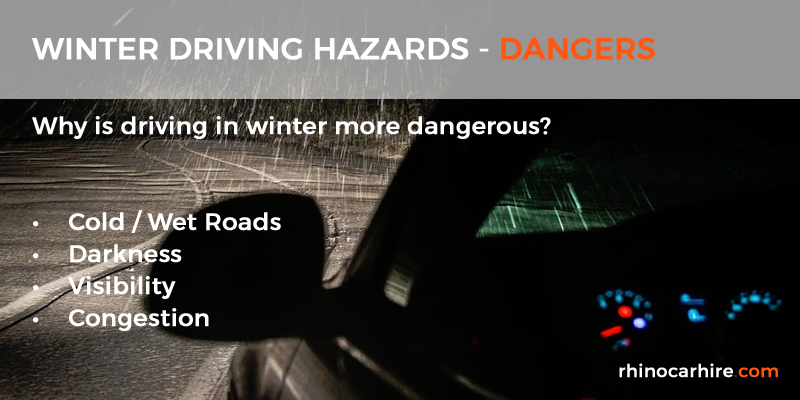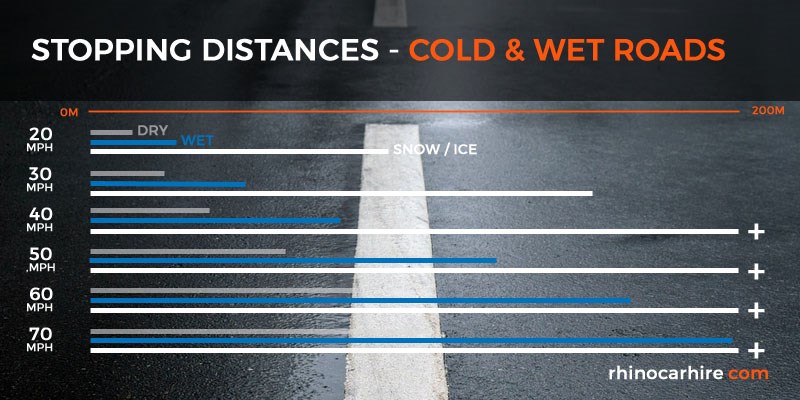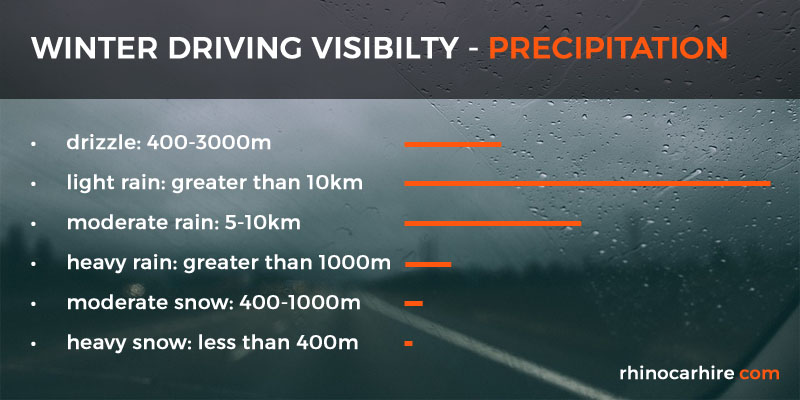A recent study carried out by a major motor insurer in the UK found that the 5th December was considered the most hazardous day to be on the roads. More insurance claims, resulting from car accidents occurred on this day than any other. It’s little surprise that this day fell in the winter in the UK as driving in winter poses many hazards and dangers that are unique to this time of year. We explore the reasons why driving in winter is more hazardous and what you can do stay safe while driving in winter.

The main factors that contribute to driving conditions in winter being more hazardous than any other time of year include;
- Cold / Wet Roads
- Darkness
- Visibility
- Congestion
Darkness
It’s not only rain / snow that will limit your visibility when driving in winter, another obvious issue is the lack of light. In the UK you can expect on average only 8 hours of daylight during winter months with sunset around 8am and sunset 4pm. Add to that, the weather is generally more unsettled so even when it is technically daylight, precipitation and cloud cover will reduce light levels further. As most car journeys occur between 7-9am and 4-6pm (UK rush hour), the roads are at their busiest when it’s dark.
Whilst cars are fitted with ever sophisticated and brighter headlights and streetlights generally light the roads, reports have proven that it’s harder to judge distances and speeds, both crucial skills for driving safely, in low or artificial lighting. Oncoming headlights can also dazzle your vision and add to the challenge of driving at night.
Cold / Wet Roads
Average temperatures in the UK are at their lowest in winter, typically around 2-5 degrees, some 15 or so degrees lower than summer months. Whilst total rainfall in the UK is less obvious, the number of rainy days per month is also at its highest in winter, averaging 17-18 nationwide, meaning the roads are less likely to dry out. (the lower temperatures exacerbating the issue). Braking distances are doubled in wet conditions and multiplied by up to 10x in snow / icy conditions.

Stopping Distances on Cold / Wet Roads
SPEED
DRY
WET
SNOW / ICE*
* it can take up to 10x the distance to stop on snow / ice
When the temperature is below 7 degrees celcius, normal car tyres will be less effective than
winter tyres which use a softer rubber compound to generate more grip in low temperatures. Ask yourself,
should I buy winter tyres and are they worth it?
Glare is another issue when driving in winter, the roads are at their busiest during sunrise and sunset in the UK meaning it’s likely you will be faced with glare from a low sun. A wet road will reflect glare up to twice as much as a dry road and a snow covered road or landscape increases this glare even more. Another reason to ensure you have a pair of sunglasses in your
winter driving emergency kit!
Visibility
Being able to see the road ahead and all around you is a vital part of safe driving, enabling you to react to the environment, both physical and other road users, around you. Inclement weather and precipitation significantly reduces visibility, a study the Bureau of Meteorology found that the following types of precipitation affected visibility as follows;

- drizzle: 400-3000m
- light rain: greater than 10km
- moderate rain: 5-10km
- heavy rain: greater than 1000m
- moderate snow: 400 - 1000m
- heavy snow: less than 400m
These distances are based on a view from an unobstructed windscreen, so add in the effects of precipitation on the windscreen and these figures could be significantly reduced. Another reason to ensure your wiper blades are well maintained when carrying out your
car winter maintenance.
Congestion
Congestion is a bit of a viscous circle, our roads are at their busiest in winter when all the elements are conspiring to make it as hazardous as possible. All of the above items covered only add to the likelihood of an accident which in turn lead to increased congestion. Whilst major and high speed accidents are less likely on congested roads, low speed accidents are all to common in congestion when it’s easy to loose concentration or make silly mistakes at the wheel, all feeding into the viscous congestion circle.
Rubbernecking is not a new phenomena and sadly is the cause of many secondary accidents, particularly on motorways when an accident in one direction, causes intrigue and interest by motorists on the opposite carriageway which can so easily cause a further accident.
Comments